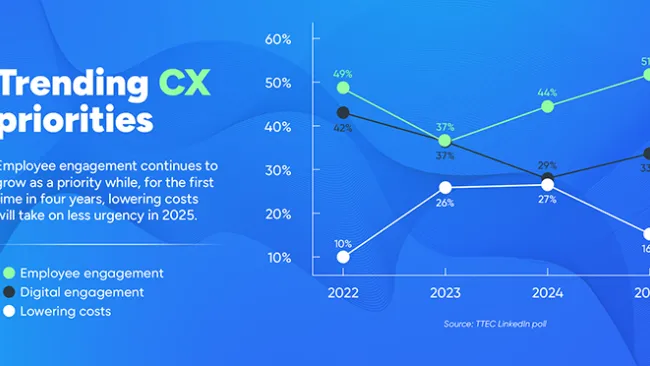Trust is an essential element of any healthy relationship— both in and out of the workplace. Employees who don't feel that management trusts them, or who don't trust management, tend to be unproductive, churn faster, and may deliver lackluster customer experiences.
As a result, trust is a vital component of a healthy workplace. But, today, with many executives singularly focused on short-term financial gains, trust seems to be disappearing from our corporate makeup. If we can't get employees to trust us, then how can we get customers to trust us?
That's why companies must work to foster trust among their employees to improve morale, increase customer loyalty, and grow our businesses. We believe there are five areas critical to building and maintaining trust among employees.
1. Recruiting: Employee trust starts by building a relationship with applicants even before they're hired. Recruiting strategies are important in terms of attracting the appropriate applicants to work at your business and serve as a critical opportunity to start the trust relationship.
Throughout the recruiting process at TeleTech, for example, we spend time using a variety of outreach channels, including social media sites like Facebook, job boards like CareerBuilder, and tools like SMS recruiting to develop the relationship early on and to get the candidates interested in our company culture. That clear picture starts with our brand promise and messaging in recruitment advertising.
We stress the great advantages of working for a global company that has been in business for close to 30 years. In addition, we highlight the experience available to someone who is entering our company in a customer service role.
Trust-building also happens with the first conversation that we have with prospective candidates. We provide them with an honest depiction of the job and their respective responsibilities. For example, we tell them about the potential challenges of the role they're applying for, as well as the benefits, and we ask them to take an honest look at everything involved. The process gives applicants a preview of what's to be expected. Through our attempts at establishing that communication they can easily decipher if there's a trust fit between them and us.
Additionally, during our hiring process applicants complete an assessment through a tool that we designed to detect trust-like competencies such as conscientiousness and responsibility. Our internal team of industrial psychologists built the assessment questionnaire to measure customer service aptitude. Those competencies and aptitudes are determined through a set of questions like "Will I show up on time?" and "Will I treat customers the way I want to be treated?"
Our hiring process also includes automated simulations and dynamic role-plays that evaluate several competencies that underlie success, including customer service orientation, problem solving, and conscientiousness. Our industrial psychologists developed these customized tools and technologies to immerse candidates in a realistic environment. This approach gives visibility into applicants' likelihood for success in certain roles, as well as their potential for having that trust fit with the organization.
2. Hiring and onboarding: Many companies often fail to implement effective onboarding programs for new hires, which often results in poor performances and, ultimately, low employee retention. At TeleTech, we believe the hiring and onboarding process is an opportune time to continue to foster the trust relationship with employees.
In our aim to achieve that, we have an onboarding program called TeleTech Essentials that is designed to welcome new employees and immerse them into the company culture. We spend valuable time with the new hire. We assign coaches who can help the associates become successful. The coaches spend significant time teaching employees skills like how to use the customer experience center resources effectively to realize performance gains. We also use an engagement survey to evaluate the relationship between the team leader and the associate. There are a few questions specifically about trust, such as "I am viewed as a trusted advisor," or "On my team, people treat one another with trust and mutual respect." As a result, employees feel knowledgeable and valued and they know what we expect of them in the first 90 days.
3. Training: After new employees complete the TeleTech Essentials onboarding program, they begin a customized training program. In the case of our customer care employees, they learn all they will need to know about relevant products and processes to serve a specific client's customers and deliver a superior customer experience. A key component of this training program is the use of simulated learning—a controlled call-simulation environment that reproduces the operational environment in the comfort of the classroom. Learners start performing live call simulations from day one of training with simple customer inquiries.
The call scenarios evolve in complexity as new material, processes, and procedures are learned. Through this simulated learning environment, learners experience the "job shock" of what it takes to be a customer service associate from the first day of training, preparing them for the next stage of training known as "nesting," when they will begin to take real customer calls in a controlled and monitored environment.
Nesting is typically a two- to four-week period in which nesting coaches shadow the new hires on the frontlines. We call it nesting because the coaches act like mother birds that hover and take care of the new hires as they learn to take the first steps into live production. The nesting coaches are usually experts on customer care, and provide product knowledge, role playing, and coaching on everything from soft skills to how to handle rebuttals.
This phased approach to training creates an environment in which the new hires feel like they can succeed, which helps to build trust in the organization.
4. Measuring and motivating: Measuring employee performance is an important part of the trust component because you can't reward what you can't measure. For example, we separate our frontline employees into quartiles determined from the key performance metrics that they have to attain based on their role. Some have 20 metrics they need to work toward; others have less. The four common measurements we use with all associates are customer satisfaction, average handle time, first-call resolution, and call quality.
5. Rewarding: Rewarding employees is one of the most important steps in building trust. We use a pay-for-performance methodology for our frontline staff. Based on a combination of tenure and performance measurement rankings, associates get a certain percentage of their base pay as a variable component. We also offer a program called TDP (Talent Development Program) that is designed to prepare associates to take the next step in their career to a team leader. It has a particular focus on coaching training.
Finally, we have dozens of recognition activities that happen across the globe every day. From our values in action award to team awards for top performance each month, we place a premium on investing in highlighting top achievers.
Building trust among employees isn't difficult, but it takes an investment in finding associates with the right skill sets, nurturing programs, and transparency. The employee-company trust relationship is crucial to reaching top performance at the employee and company level, and is a critical component in effective customer engagement. It's an investment worth making because if employees are performing well, then everyone wins.















